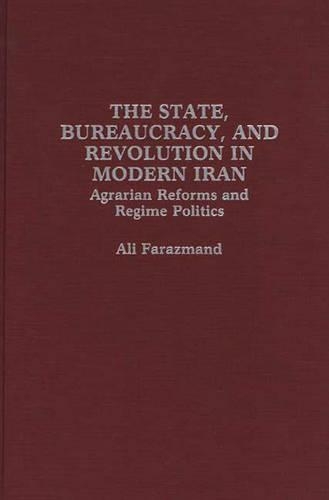
The State, Bureaucracy, and Revolution in Modern Iran: Agrarian Reforms and Regime Politics
(Hardback)
Publishing Details
The State, Bureaucracy, and Revolution in Modern Iran: Agrarian Reforms and Regime Politics
By (Author) Ali Farazmand
Bloomsbury Publishing PLC
Praeger Publishers Inc
8th December 1989
United States
Classifications
Tertiary Education
Non Fiction
Central / national / federal government policies
333.3350955
Physical Properties
Hardback
303
Width 156mm, Height 235mm
624g
Description
Covering the period from 1950 through 1988 this book examines the role of a large bureaucracy under the Shah and post-revolutionary changes in that bureaucracy under the Islamic Republic. It focuses on the role of one of the most powerful bureaucracies in Iran, the Ministry of Agriculture and Rural Development (MARD). The author explains how the MARD transformed rural Iran from a feudalistic social system to a capitalistic system of economy. It helped maintain and enhance the Pahlavi regime under the Shah by developing and guarding capitalism in rural Iran. These two objectives were achieved through rural bureaucratization and extension of the State's control to the remotest areas of Iran. The author also discusses the impact of the Revolution of 1978-79 on Iranian bureaucracy. Iran has been one of the oldest historical bureaucratic empires the world has ever known. During the Pahlavi regime, bureaucracy was the main instrument of policy formulation and ligitimation. This book fills many of the gaps in our present knowledge of Iranian bureaucracy, particularly in relation to agrarian reform and regime politics. Ali Farazman has based his study on primary data including 150 interviews, the examination of numerous government documents, and, as a former Iranian administrator, direct observations. MARD was chosen as this book's focus for several reasons. It was central to the Shah's regime during the 1960s-1970s. Until the 1960s three quarters of Iran's population lived in rural areas under a feudal system. During this period MARD grew at an unprecedented rate. Through land reform it created a new class of allies for the Shah. It was instrumental in the destruction of Iran's agriculture, making it dependent on foreign imports. It contributed nine million rural migrants to the cities ultimately fueling the Revolution of 1978-79. The author has chosen MARD as representative of a power Iranian bureaucracy.
Reviews
"Dr. Farazmand's experiences in Iran as an administrator and researcher, as illuminated by his studies in the United States, give his analysis great objectivity and balance, and politics and administration."-Fred W. Riggs Professor Emeritus, University of Hawaii
. . . The book is a useful addition to the spate of studies about recent developments in Iran's bureaucracy and its rural sector, such as those by Fred Halliday, Eric Hooglund, and others. Although there is an extensive bibliography, much of the study derives from some 150 interviews conducted by the author.-Perspectives on Political Science
Farazmand, a former bureaucrat in the Pahlavi state administration, argues that the latter functioned more to maintain the state and to control society than to provide its population with services and with help for development. In the long run, such a self-serving thrust proved destructive and was one reason for the state's final collapse in the 1979 revolution. In Farazmand's view, the Khomeini state moved in the same direction, despite more auspicious beginnings that emphasized service functions. The focus throughout is on bureaucracy in the rural areas, with detailed investigations of the role of the Ministry of Agriculture and Rural Development, as well as local government and quasi-government institutions (such as cooperatives). Strangely, no references are made to Grace Goodell's pioneering The Elementary Structures of Political Life. Goodell's ethnographic account clearly underscores the paternalistic/authoritarian nature of the Pahlavi state and critiques the World Bank-inspired model for rural development planning from above. Also missing from the bibliography is Afsaneh Najmabadi's Land Reform and Social Change in Iran. This book, is, nonetheless, a useful contribution to the literature on rural Iran, especially because it traces the evolution of increasing state bureaucratization in the countryside. Most likely users are upper-division undergraduate and graduate students.-Choice
." . . The book is a useful addition to the spate of studies about recent developments in Iran's bureaucracy and its rural sector, such as those by Fred Halliday, Eric Hooglund, and others. Although there is an extensive bibliography, much of the study derives from some 150 interviews conducted by the author."-Perspectives on Political Science
"Farazmand, a former bureaucrat in the Pahlavi state administration, argues that the latter functioned more to maintain the state and to control society than to provide its population with services and with help for development. In the long run, such a self-serving thrust proved destructive and was one reason for the state's final collapse in the 1979 revolution. In Farazmand's view, the Khomeini state moved in the same direction, despite more auspicious beginnings that emphasized service functions. The focus throughout is on bureaucracy in the rural areas, with detailed investigations of the role of the Ministry of Agriculture and Rural Development, as well as local government and quasi-government institutions (such as cooperatives). Strangely, no references are made to Grace Goodell's pioneering The Elementary Structures of Political Life. Goodell's ethnographic account clearly underscores the paternalistic/authoritarian nature of the Pahlavi state and critiques the World Bank-inspired model for rural development planning from above. Also missing from the bibliography is Afsaneh Najmabadi's Land Reform and Social Change in Iran. This book, is, nonetheless, a useful contribution to the literature on rural Iran, especially because it traces the evolution of increasing state bureaucratization in the countryside. Most likely users are upper-division undergraduate and graduate students."-Choice
Author Bio
ALI FARAZMAND is currently an Assistant Professor and Director of the Public Administration Program at the University of Pittsburgh. He is also the author and editor of three forthcoming books: Crisis in the U.S. Administrative State: A Political Economy Analysis (Praeger), State and Bureaucracy in Persia (Iran): 4,000 Years of Public Administration (Praeger), and Handbook of Comparative and Development Public Administration and Policy.
